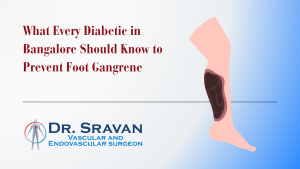Living with diabetes in a city like Bangalore brings enough challenges—long work hours, erratic meals, traffic stress. But there’s one silent danger you might not even feel coming: foot gangrene. And by the time it shows up, it could be too late.
As a vascular and endovascular specialist, I’ve seen far too many patients who ignored a small wound or numb toe—only to land up needing surgery or even amputation.
Let’s not let that happen to you or your loved ones.
👣 What Are the Symptoms of Diabetic Foot Gangrene?
Gangrene doesn’t begin as something dramatic. It creeps in quietly—especially if you’ve lost foot sensation due to neuropathy.
Look out for:
-
Unhealing wounds or ulcers on the foot
-
Black, blue, or grey discoloration of skin (especially toes)
-
Coldness in the foot or part of the foot
-
Foul-smelling discharge from a wound
-
Swelling or sudden pain in one foot
-
Loss of sensation or tingling
⚠️ If you have diabetes and notice ANY of these, consult a vascular surgeon immediately. Early detection can save your foot—and your life.
🔍 What Causes Gangrene in Diabetics?
Gangrene usually develops when there’s a lack of blood flow and oxygen to tissues, which leads to decay.
For diabetic patients in Bangalore, these are the key culprits:
1. Peripheral Artery Disease (PAD)
Narrowed arteries reduce blood flow to the feet, making healing slower.
2. Neuropathy
Diabetes damages nerves. You might injure your foot without even knowing it.
3. Infections
A simple blister or shoe bite can become infected. If untreated, infection spreads to muscles and bones.
4. Poor Foot Hygiene & Tight Footwear
Wearing tight shoes in Bangalore’s humid climate can cause unnoticed injuries or fungal infections.
💉 How is Diabetic Foot Gangrene Treated?
At Dr. Sravan’s Vascular Clinic in Bangalore, we focus on limb salvage—saving your foot using advanced, non-invasive or minimally invasive treatments.
Here’s how we treat gangrene:
1. Wound Debridement
Cleaning out dead tissue is the first step.
2. Antibiotic Therapy
Strong antibiotics are prescribed to control infection.
3. Revascularization (Angioplasty or Bypass)
If there’s blocked blood flow, we restore it using advanced vascular techniques like:
-
Peripheral angioplasty
-
Stenting
-
Bypass surgery (in severe cases)
4. Hyperbaric Oxygen Therapy (for selected cases)
Oxygen-rich environments help heal stubborn wounds faster.
In rare cases where tissue death is extensive, surgical removal (amputation) might be necessary—but our aim is always to prevent that.
🛡️ How Can You Prevent Foot Gangrene if You’re Diabetic?
Prevention is the most powerful treatment. If you live with diabetes, follow these steps diligently:
👣 Daily Foot Check
Use a mirror or ask a family member to check the soles, toes, and nails every evening.
🧼 Wash & Moisturize
Keep feet clean, dry, and moisturized—especially the heels and in-between toes.
🥿 Choose the Right Footwear
Wear soft, wide shoes. Avoid tight sandals or heels.
🏃♀️ Keep Moving
Regular walking improves blood circulation to the feet.
🩺 Get Regular Vascular Screenings
If you’re diabetic and over 40, get a vascular check-up once a year with a specialist.
🩺 When Should You See a Vascular Surgeon?
Don’t wait until it’s too late. Consult Dr. Sravan if you notice:
-
A wound that hasn’t healed in 7 days
-
Blackish discoloration or skin changes
-
Numbness or burning in the feet
-
Visible veins or swelling in legs
In Bangalore, access to expert care is not a luxury—it’s a necessity. We’re here to prevent amputations and preserve mobility.
❓ FAQs About Diabetic Foot Gangrene
🔹 1. Is gangrene reversible?
Gangrene itself isn’t reversible, but early detection can stop its progression. With timely vascular treatment, tissue death can be minimized or avoided.
🔹 2. Can foot gangrene be treated without surgery?
Yes—minimally invasive procedures like angioplasty can restore blood flow without major surgery, especially if diagnosed early.
🔹 3. Does Bangalore’s weather affect diabetic foot care?
Yes. Humid conditions increase the risk of fungal infections and skin breakdown. Foot care is even more important here.
🔹 4. What is the first sign of diabetic foot complications?
Loss of sensation or a small wound that doesn’t heal is often the first clue. Don’t ignore even a minor injury.
🔹 5. Can gangrene be fatal?
Yes, if untreated, infection from gangrene can spread into the bloodstream (sepsis), which can be life-threatening.
📞 Don’t Wait for a Wound to Become a Warning
If you’re living with diabetes in Bangalore, take the first step toward prevention today. Book a foot screening with Dr. Sravan, Vascular & Endovascular Surgeon, and let us help you stay one step ahead of foot complications.
🗓️ Book your consultation now — your feet will thank you.

